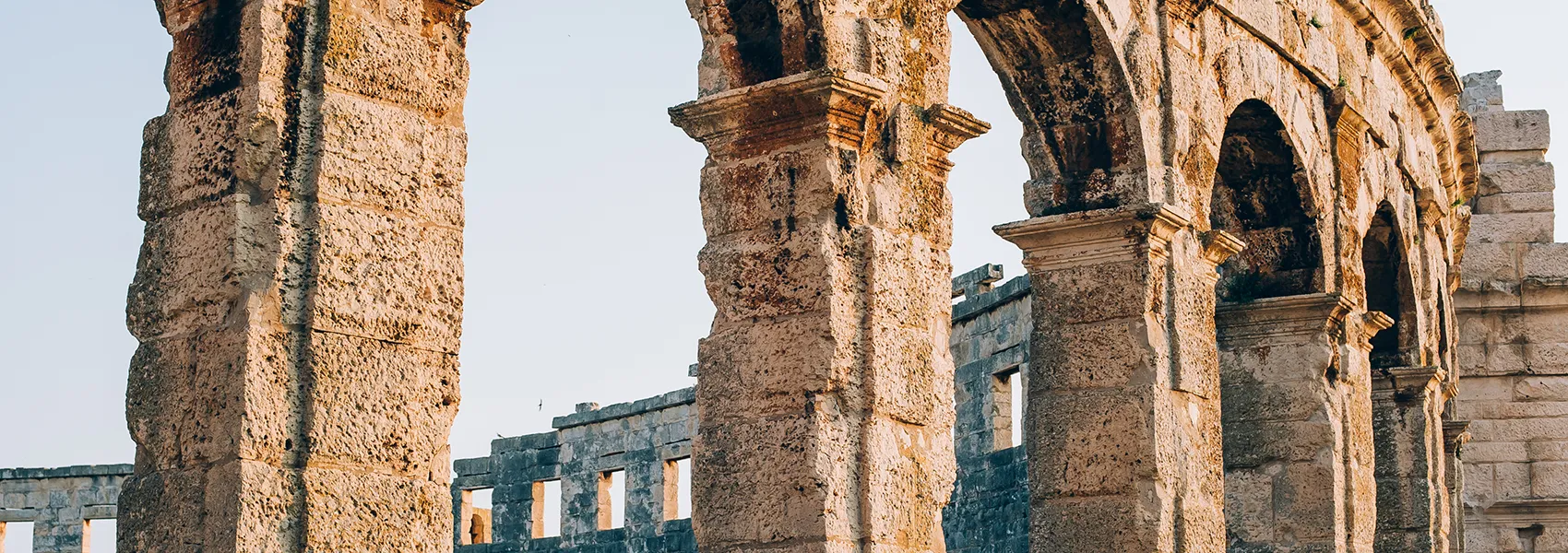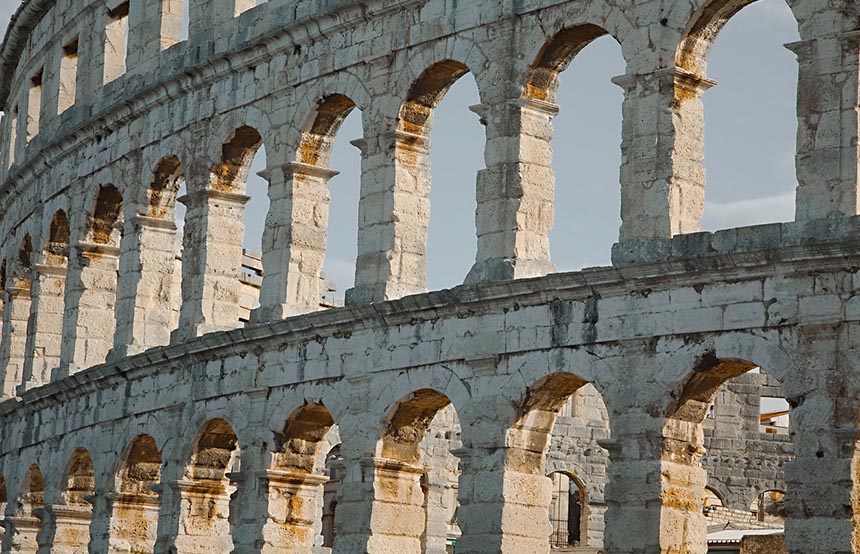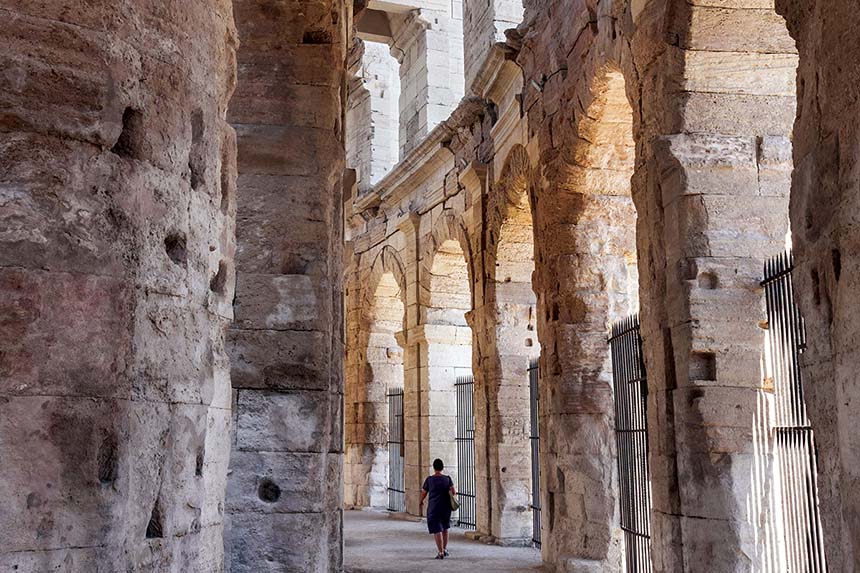
Published 7th Jul. 2023
Reading time
Gruesome gladiator clashes, breakneck chariot races and all too aggressive exotic animal fights filled Roman colosseums and amphitheatres across Europe during the Roman Empire (625 BC to AD 476). These architectural feats have fascinated history buffs for centuries and are a symbol of Rome’s once overarching presence and domination across the continent. Now, the gladiator battles have been swapped for dramatic re-enactments, chariot races replaced with brightly lit concerts and animal fights switched with professional hockey games. While the Roman Empire perished centuries ago, these amphitheatres live on as a reminder of a bygone era in which the Romans ruled the world. Here is a list of five of the most impressive colosseums around the world…
Standing proud in the heart of Rome, the Colosseum (also known as the Flavian Amphitheatre), is an architectural masterpiece that beckons visitors to step into a realm of Italian history. The towering amphitheatre, now a UNESCO World Heritage site, is the founding father of the colosseum world and remains the largest amphitheatre that the Romans ever built. Started by emperor Vespasian of the Flavian dynasty in AD 72 and finished by his son Titus in AD 80, the Colosseum was built for the citizens of Rome as a place of entertainment and is still one of the city’s most spectacular amusement venues. Its imposing and elliptical walls rise to a height of almost 160ft, its weathered stones echo with the cheers of long-forgotten crowds, and its towering arches whisper tales of valour and spectacle.

If visiting an almost perfectly preserved amphitheatre is on your bucket list, then exploring the Arena of Nimes in France is a must. Modelled on Rome’s Colosseum, this work of infrastructural art is simply spectacular. Venture in through its storied doors, which are like portals into an ancient world, and look out over the arena where brave gladiators clashed, exotic animal hunts unfolded and chariots tore up the sandy interiors. The amphitheatre has had other purposes besides housing Roman frivolities; during the Middle Ages a fortified palace was built within its centre; a small neighbourhood developed within its walls a little later; and in 1863, the arena was developed to facilitate bull fights, and hosts two annually, as well as other public events. Its history alone makes it one of the most impressive colosseums around the world.
As the sixth-largest surviving Roman arena, and one of Croatia’s finest monuments, Pula most definitely makes it into our list of the top five most impressive colosseums around the world. Once home to gruesome gladiator fights and battles between big cats, it is now mainly used as a beautiful outdoor cinema right next to the sparkling Adriatic, and its underground passages once used by fighters, now host intricate exhibitions about olive growing in the ancient times. If you’re lucky, you might catch a glimpse of the theatre productions, concerts, military ceremonies or even hockey games that take place in Istria's vast amphitheatre.
With its insides standing strong despite a catastrophic earthquake in 1117 (its pretty white and pink limestone exterior was almost completely destroyed), Italy’s Verona Arena is the world’s third-largest colosseum to have survived Roman antiquity. Along with other colosseums around the world, Verona's stadium was home to epic encounters, of brutal battles, medieval jousting and 18th-century opera. Even today, a Opera Festival is held in the arena and is thought to be one of the most bucket list-worthy opera events in the world.

Image by © Jerome Galland
Although not as well preserved as its neighbour in Nimes, Arles Amphitheatre has been crowned a UNESCO World Heritage site and is able to seat over 20,000 spectators across its looming tiers. Like its stoney counterparts, this Roman colosseum has been a sports arena since the first century BC, hosting barbaric gladiator conflicts, hand-to-hand battles and chariot races. Now, in its old age, it hosts more leisurely bullfights (believe it or not they are less brutal than chariot racing back in the day), as well as theatrical gladiator re-enactments throughout the summer.
Written by Immy Kelly
Practical advice and inspiration for your next trip

If paradise had a postcode, it would be somewhere on Bali’s coastline. Embraced by the sea on all sides, this Indonesian island is home to a bounty of beautiful beaches. Whether your perfect day means unwinding on the sand with a cocktail and a good book, learning to ride your first wave, exploring Bali’s underwater world, or sampling its lively nightlife, the island offers something for every mood and pace.
29th December 2025 - Indonesia Travel Inspiration

Love it or hate it, winter rolls around every year. So, why not spend this polarizing time on a polarized continent? From skating on the frozen lakes of the Canadian Rockies and crunching through the snow-blanketed plains of Alaska to sampling internationally renowned wines in the vineyards of Northern California and cruising between the laid-back microcosms of The Florida Keys, North America has something for everyone during winter.
24th December 2025 - USA Travel Inspiration

Have you ever felt the urge to hop on a flight after watching a particularly good film? Us too. From settings to storylines, travel and cinema are inextricably linked, taking viewers on a journey through new and exciting destinations. While this has been the case since film’s inception, the connection between the two has grown in recent years, with ‘set-jetting’ (visiting locations featured in films or television) holidays steadily on the rise.
22nd December 2025 - Travel Inspiration

Our team of destination experts will get to know you and your unique requirements for your holiday

We work with you to build an ultra-personalised holiday itinerary with your choice of accommodation, experiences and activities

All of our holidays include little extras designed to make a big difference to your trip, from fast-tracking you through airport check-in and security to our network of local Concierges